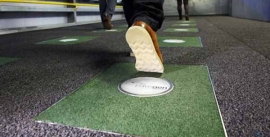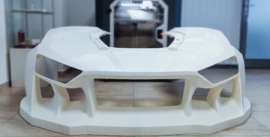 جدید
جدیدامکان تجسم فرایندهای نانومقیاس در مایعات visualize nanoscale processes in liquids
امکان تجسم فرایندهای نانومقیاس در مایعات visualize nanoscale processes in liquids
امکان تجسم فرایندهای نانومقیاس در مایعات
[box type=”shadow” align=”alignright” ] Gianneschi بیان کرد، “با این تکنیک، ما می توانیم اجزای متعدد مخلوط شده با هم را در مقیاس نانو در داخل مایع مشاهده نماییم. بنابرین، برای مثال، می توان مواد بیولوژیکی را مشاهده نمود و شاید نحوه پاسخ آنها به داروها را دید، ” درصورتیکه آن قبلا ممکن نبود. [/box]
شیمیدان ها در UC San Diego ابزار جدیدی را توسعه دادند که به دانشمندان برای اولین بار، در مقیاس پنج میلیاردیم متر،”مقیاس نانو” مشاهده پروسه های مخلوط شدن در مایعات را ممکن ساخته است.
Nathan Gianneschi ، پروفسور شیمی و بیوشیمی رئیس تیم مقاله چاپ شده در شماره این هفته مجله میکروسکوپی و میکروآنالیز (“Picoliter Drop-On-Demand Dispensing for Multiplex Liquid Cell Transmission Electron Microscopy”)، بیان کرد “توانایی دیدن شیب و واکنش های شیمیایی در مقیاس نانو به عنوان ابزار اساسی در بیولوژی، شیمی، و همه علوم مواد می باشد”. با این ابزار جدید، ما قادر به دیدن کینتیک و دینامیک تعاملات شیمیایی خواهیم بود که قبلا قابل رویت نبودند.
دانشمندان برای دیدن ساختار نانو مقیاس، از مدت ها وابسته به میکروسکوپ الکترونی عبوری ، یا TEM، بودند. اما آن تکنیک تنها می توانست تصویر استاتیک بگیرد و نمونه ها باید خشک، منجمد و در خلا نصب می شد تا رویت شوند. در نتیجه، محققین قادر به بررسی کردن پروسه های زنده یا واکنش های شیمیایی در مقیاس نانو، از قبیل رشد، انقباض داخل سلول های زنده فیبرهای کوچک یا بر آمدگی های نانو مقیاس، ضروری در حرکت و تقسیم، یا تغییرات ایجاد شده بوسیله واکنش شیمیایی در مایع، نبودند.
Gianneschi بیان کرد، به عنوان شیمیدان، ما تنها به طور واقعی محصولات نهایی یا تغییرات محلول توده، یا تصویر در وضوح کم را آنالیز می کنیم زیرا ما هرگز قادر به دیدن رویدادهایی که به طور مستقیم در مقیاس نانو رخ می دهد نیستیم.”
پیشرفت های اخیر در سلول مایع TEM، یا LCTEM، به دانشمندان امکان فیلم گرفتن از اشیاء نانو مقیاس در مایعات را می دهد. اما تکنیک به واسطه عدم توانایی در کنترل مخلوط کردن محلولها، که برای مشاهده و آنالیز تاثیر دارو بر سلول زنده یا واکنش بین دو ماده الزامی است، محدود شده است.
Joseph Peterson، محقق فوق دکتری در آزمایشگاه Gianneschi، در حال کار با محققین در SCIENION AG در آلمان و آزمایشگاه ملی Pacific Northwest، در حل این مشکل از طریق توسعه تکنیک و همچنین یک ابزاری که به دانشمندان گذاشتن مقدار کمی از مایع – حدود 50 تریلیونوم لیتر- در منطقه مشاهده میکروسکوپ LCTEM ممکن ساخت، قدم بزرگی برداشته است.
Gianneschi بیان کرد، “با این تکنیک، ما می توانیم اجزای متعدد مخلوط شده با هم را در مقیاس نانو در داخل مایع مشاهده نماییم. بنابرین، برای مثال، می توان مواد بیولوژیکی را مشاهده نمود و شاید نحوه پاسخ آنها به داروها را دید، ” آن قبلا ممکن نبود.
او اضافه کرد، ” منافع برای پژوهش های پایه زیاد می باشد”. “ما الان قادر به دیدن مستقیم رشد در مقیاس نانو در همه چیزها، شبیه فیبرهای طبیعی یا میکروتوبولها هستیم. علاقه مندی زیادی در محققین در فهم نحوه تاثیر سطح نانوذرات بر واکنش شیمیایی یا چگونه نواقص نانو مقیاس در سطوح توسعه مواد وجود دارد. ما در نهایت می توانیم فصل مشترک نانو ساختارها را مشاهده و توسعه انواع جدیدی از کاتالیست ها، رنگها و سوسپانسیونها را بهینه نماییم”.
اگر چه دانشمندان از ابزارشان برای مشاهده واکنش شیمیایی در محلول استفاده نکرده اند، آنها نشان دادند که تکنیک برای فراهم نمودن مخلوط کردن با استفاده از ترکیبی از نانوذرات طلا و دیگر کریستالهای نانو مقیاس معلق شده در مایع بکار می رود.
Gianneschi گفت ” آنچه ما نشان دادیم اثبات مفهوم است،”.” اما آن چیزی است که بعداً انجام خواهیم داد.”
اگر چه ابزار جدید به دانشمندان امکان مشاهده واقعی مولکولها در محلول خواهد داد، Gianneschi گفت آنها باید قادر به مشاهده تاثیر واکنش های شیمیایی باشند که در موادی که بزرگتر از پنج نانو متر هستند رخ می دهد.
او افزود ، “ما نمی توانیم برخورد مولکولها را مشاهده نماییم، اما ما قادر به مشاهده ذرات منفرد و مجموعه ای از آنها، در مقیاس نانومتر هستیم،”. مشاهده این نوع از پروسه ها یکی از چالش های کلیدی در علم نانو می باشد.
[box type=”info” align=”alignright” width=”1124″ ]منبع : nanowerk.com
ترجمه از کمیته استاندارد نانو [/box]
[divider]
New tool allows scientists to
visualize nanoscale processes
in liquids
(Nanowerk News) Chemists at UC San Diego have developed a new tool that allows scientists for the first time to see, at the scale of five billionths of a meter, “nanoscale” mixing processes occurring in liquids.
“Being able to look at nanoscale chemical gradients and reactions as they take place is just such a fundamental tool in biology, chemistry and all of material science,” said Nathan Gianneschi, a professor of chemistry and biochemistry who headed the team that detailed the development in a paper in this week’s issue of the journal Microscopy and Microanalysis (“Picoliter Drop-On-Demand Dispensing for Multiplex Liquid Cell Transmission Electron Microscopy”). “With this new tool, we’ll be able to look at the kinetics and dynamics of chemical interactions that we’ve never been able to see before.”
Scientists have long relied on Transmission Electron Microscopy, or TEM, to see structures at the nanoscale. But that technique can take only static images and the subjects must be dried, or frozen and mounted within a vacuum chamber in order to be seen. As a result, researchers have been unable to view living processes or chemical reactions at the nanoscale, such as the growth and contraction within living cells of tiny fibers or nanoscale protrusions, essential in cell movement and division, or the changes caused by a chemical reaction in a liquid.
“As chemists, we could only really analyze the end products or bulk solution changes, or image at low resolution because we could never see events directly occur at the nanoscale,” said Gianneschi.
Recent developments in Liquid Cell TEM, or LCTEM, have allowed scientists to finally take videos of nanoscale objects in liquids. But that technique has been limited by the inability to control the mixing of solutions, a requirement when trying to view and analyze the impact of a drug on a living cell or the reaction of two chemicals.
Joseph Patterson, a postdoctoral researcher in Gianneschi laboratory, working with researchers at SCIENION AG in Germany and Pacific Northwest National Laboratory, has taken a big step to resolving that problem by developing a technique as well as a tool that allows scientists to deposit tiny amounts of liquid — about 50 trillionths of a liter — within the viewing area of the LCTEM microscope.
“With this technique, we can view multiple components mixed together at the nanoscale within liquids, so, for example, one could look at biological materials and perhaps see how they respond to a drug,” said Gianneschi. “That was never possible before.”
“The benefits to basic research are huge,” he added. “We will now be able to directly see the growth at the nanoscale of all kinds of things, like natural fibers or microtubules. There’s a lot of interest on the part of researchers in understanding how the surfaces of nanoparticles affect chemical reactions or how nanoscale defects on the surfaces of materials develop. We can finally look at the interfaces on nanostructures so that we can optimize the development of new kinds of catalysts, paints and suspensions.”
While the scientists have not yet used their tool to view chemical reactions in solution, they have demonstrated that the technique works to provide mixing using combinations of gold nanoparticles and other nanoscale crystals suspended in a liquid.
“What we’ve demonstrated is the proof of concept,” said Gianneschi. “But that’s what we’ll be doing next.”
Although this new tool won’t allow scientists to actually view molecules in solution, Gianneschi said they should be able to see the impact of chemical reactions that are occurring on materials that are bigger than five nanometers.
“We won’t be observing molecules colliding, but we will be able to observe single particles and collections of them, on the nanometer length scale,” he added. “Observing these kinds of processes has been one of the key challenges in the field of nanoscience.”









دیدگاه کاربران